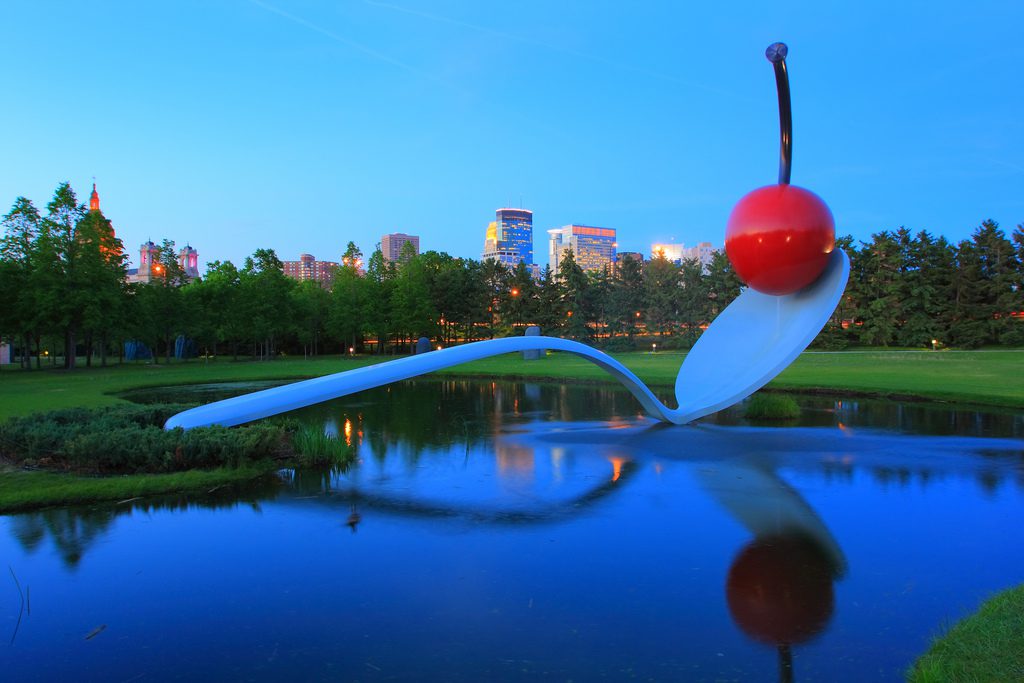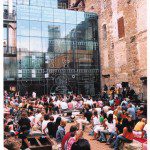In a matter of weeks, trees covered in lush green leaves will soon break into their autumnal spectrum. Hazy summer bliss, however, lingers and bids late vacationers to make their plans before the first frosty morning. In Minneapolis, that’s usually around October, but in August, the western half of Minnesota’s Twin Cities is a balmy treasure of fine attractions, and the arts are rampant. If Minneapolis is on the radar for a quick out-of-town getaway, the City of Lakes is abound in sophisticated culture with alcoves of quirky charm throughout. Those who look for it will find Minneapolis a thriving metropolis filled with a spirit of discovery from its history to the present. Get a closer look at the beauty, architecture and art of a city that knows what it is to live in a masterpiece.
Mill City Museum Minneapolis was once the flour mill capital of the world, and the Mill City Museum stands as a reminder of those days. Constructed into the ruins of what was once the Washburn A Mill built in 1874, the museum was created by the Minnesota Historical Society after the Minneapolis Community Development Agency cleaned up the abandoned site and fortified its aged walls. In its milling heyday between 1880 and 1930, the mill turned out enough flour to make 12 million loaves of bread daily. Today, Mill City Museum exhibits old factory equipment, an interactive Water Lab highlighting the impact of nearby St. Anthony Falls on local industries, a ride up the Flour Tower, the Baking Lab and an explosive surprise. www.millcitymuseum.org
Weisman Art Center Located on the University of Minnesota campus in Minneapolis, the Weisman Art Center features a stunning collection of work by such 20th century American artists as Georgia O’Keeffe and Marsden Hartley as well as art across all disciplines. But the art isn’t just on the inside – the Weisman Art Center was designed by Frank Gehry, the architect famed for creating the ribbon-like splendor in effect at downtown Los Angeles’ Walt Disney Concert Hall and at the Guggenheim Museum Bilbao in Spain as well as the Cubist-inspired Ray and Maria Stata Center at MIT. The Weisman is a teaching center, which means the art created and shown there is ever-changing and evolving. www.weisman.umn.edu
Walker Art Center The Walker Art Center’s prestige goes deep like its long-established origins – when lumber tycoon T.B. Walker built a room onto his house in which to hang his 20 favorite paintings, he opened the doors, allowing anyone who wanted to view them inside. That beginning in 1879 was the catalyst for an institution that has grown into an internationally recognized center for visual arts, performing arts and creativity. Housing a diverse and expansive range of contemporary art, the campus also includes exhibition galleries, performance spaces, architectural marvels and the Minneapolis Sculpture Garden, home to brilliant landscaping, water features and sculptures. The most famous of its artworks, Claes Oldenburg and Coosje van Bruggen’s Spoonbridge and Cherry, has become iconic of the city itself. www.walkerart.org
Guthrie Theater When the founders of the Guthrie Theater started it in 1963, their goal was to create a first-rate acting company devoted to producing classic work out-of-reach from commercially driven Broadway. Sir Tyrone Guthrie and his partners accomplished that goal and created a center focused on theater excellence and education. In 2006, construction was completed on a new facility featuring three stages, a coffee bar, restaurant and the Endless Bridge – a cantilevered lobby extending more than half a block from the theater toward the Mississippi River. The design helped earn architect Jean Nouvel the Pritzker Architecture Prize. Currently, the theater features productions of My Fair Lady and Christopher Durang’s 2013 Tony Award-winning Best Play Vanya and Sonia and Masha and Spike through the month of August. www.guthrietheater.org
Stone Arch Bridge Minneapolitans love their historic Stone Arch Bridge so much that they hold a festival for it every June. The rest of the year, residents and visitors alike admire the old bridge, which was built in 1883 as a railroad crossing over the Mississippi River. Made of granite and limestone for its entire length, the bridge is now for pedestrians and bicycle riders only, and as part of the Saint Anthony Falls Historic District, it is on the National Register of Historic Places. Located just below Saint Anthony Falls, the bridge is a lovely foreground to shots of downtown Minneapolis and the skyline. It’s also a favorite gathering place. www.stonearchbridge.com
Nicollet Mall Nearby Bloomington’s Mall of America seems to be the most famous mall in the Twin Cities region, but Nicollet Mall is Minneapolis’ commercial heart. Running for 12 blocks on Nicollet Avenue, the stretch is a picturesque pedestrian district running through downtown and lined with such stores as Saks Fifth Avenue OFF 5th and Macy’s. The district is also known for its theaters, restaurants and nightspots, many located within some of the town’s historic buildings. On Thursdays, the Nicollet Mall Market sets up with produce vendors and more.
At A Glance
Access: Arrive in Minneapolis through the Minneapolis-Saint Paul International Airport. Get around town by a light rail system, city buses and taxis. Commuter trains run to Saint Paul and the suburbs. The city also features many dedicated bike lanes.
Climate: Temperatures in August average in the low 80s and drop about 10 degrees each successive month through fall and winter.
Main attractions: NFL Minnesota Vikings, Minnehaha Falls, Basilica of Saint Mary, NBA Minnesota Timberwolves
Festivals
Minnesota Fringe Festival: Fringe festivals – those showcases of theater and performance arts that take over cities in a flurry of unbridled creativity – are turning up everyone around the world, but one of the oldest and largest of them hits Minneapolis every summer. The Minnesota Fringe Festival this year features 169 performances across 11 days at 19 venues from July 31 to Aug. 10. Exciting and unique, Minnesota Fringe frequently uncovers cool new talent and voices in arts. www.fringefestival.org/2014/
Ethnic festivals: We usually think of Nordic heritage when we consider the early days of Minnesota statehood and immigration, but the region also is steeped in Celtic culture. That tradition is celebrated with the Welsh North American Association’s North American Festival of Wales, and visitors get to experience all the hallmarks, including songs, Welsh food, crafts and art. A line-up of lectures is also scheduled for Aug. 28-31 (www.thewnaa.org). Also in August, look for Irish Fair of Minnesota (www.irishfair.com), FinnFest USA 2014 (www.finnfestusa2014.org) and the Twin Cities Polish Festival (tcpolishfestival.org).
Stay In Style
W Minneapolis Hotel: Tulsa isn’t the only city with stunning Art Deco architecture: The Foshay Tower was constructed in 1929 just before the stock market crash that sent the U.S. into the Great Depression. Today, it is the W Minneapolis. Sumptuous for its time when it was built, the W Minneapolis is still decadent with a contemporary elegance that complements this historic structure. Visitors frequently remark on the views from the 30th floor observation deck and the Prohibition Sky Bar on the 27th floor. www.wminneapolishotel.com
Le Meridien Chambers Hotel: A weekend of the arts deserves a stay in accommodations created for both aesthetic and physical comforts. The luxurious Le Meridien Chambers Hotel is located in the heart of the city close to Nicollet Mall and the Hennepin Theater District. Classic luxury and the arts blend seamlessly with more than 200 art works displayed throughout this boutique hotel located in two landmark buildings. So committed is Le Meridien Chambers that the hotel partnered with the Walker Art Center. The key card guests receive at Le Meridien and Minneapolis Art Hotel opens more than just a room door. www.lemeridienchambers.com





































